2023 Miles Franklin Shadow Jury
About
Literature has the remarkable ability to transport us to different worlds, evoke emotions, and ignite our imagination. It is a form of art that holds immense value and impact in society. The Miles Franklin Award, established in 1957, holds a significant place in the history of Australian literature. Named after acclaimed Australian author Stella Maria Sarah Miles Franklin, the award aims to recognise and celebrate the best works of fiction that depict and contribute to Australian life. It was initially established through a bequest in Franklin's will, with the intention of encouraging and supporting the development of uniquely Australian literature.
Over the years, the award has evolved to become one of the most prestigious literary honours in the country. It has showcased the diversity, depth, and creativity of Australian storytelling, honouring exceptional works that capture the essence of the nation's cultural landscape. The Miles Franklin Award continues to play a vital role in promoting Australian literature and inspiring future generations of writers to share their unique perspectives and narratives with the world.
What is the Miles Franklin Shadow Jury?
A shadow jury is an independent panel of passionate readers, critics, and literary enthusiasts who come together to review a longlist of books. While the official judging panel ultimately determines the award-winning book, the shadow jury offers an alternative lens through which to appreciate and analyse the longlisted works.
In this post, we present reviews from our shadow jury, which included students, writers and critics from UQ who delved into each longlisted book. Through these reviews, we aim to provide readers with a multifaceted understanding of the longlisted works and spark engaging conversations about their literary significance.
Why the Longlist?
In the world of literary awards, the longlisted books often occupy a unique space. While the spotlight tends to shine on the eventual winners, these longlisted gems often offer a more diverse and intriguing glimpse into the state of contemporary Australian literature. It is unfortunate that they seldom receive the same level of attention and recognition as their shortlisted counterparts. However, the introduction of a shadow jury brings an opportunity to shed light on these deserving works.
Through our series of reviews, we aim to celebrate the richness and variety found within the longlisted books, amplifying their voices and showcasing the captivating narratives that might otherwise go unnoticed. Join us in exploring the depths of contemporary Australian literature as we uncover the hidden treasures within the longlist.
Hopeless Kingdom
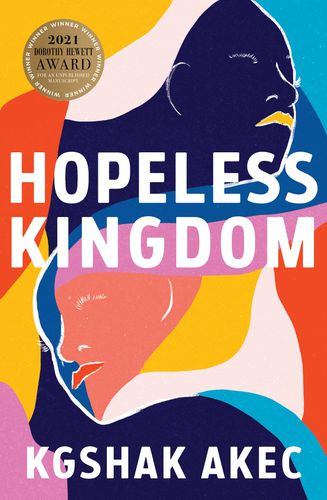 Kgshak Akec, Hopeless Kingdom (UWA Publishing)
Kgshak Akec, Hopeless Kingdom (UWA Publishing)
Reviewed by Doreen Baingana
What does one expect from a novel about immigration? Transition, dislocation, the change of self in a new environment, perhaps. Under this broad umbrella, however, as with the proverbial unhappy family, each immigrant family deals with the transition in its own unique way. “Hopeless Kingdom” soars above the expected as it evokes with an empathetic lyricism the particularities of and pressures on a Sudanese refugee family that moves from its war-torn home country to Egypt and finally to Australia. This impressive first novel is less about immigration itself, and more about family as a living organism that once uprooted, wills itself to do more than survive. Can it possibly thrive as it plants itself in new ground?
This question is explored from two perspectives, a mother’s and daughter’s, which the author weaves together smoothly and skillfully as alternating voices, creating a broader tapestry for the revelation of motivation and theme. The family’s journey starts when Akita, the daughter, is almost six and follows the family’s fortunes until she is a young adult, with flashbacks by the mother, Taresai, of her painful childhood. Forced to flee from Sudan’s civil war, Taresai, her husband Santino, and their three children are unsettled in Cairo, as Akita and her brother Santo face racism at school, and the parents barely make ends meet. They are elated when they get the opportunity to immigrate to Australia, even though this will mean leaving Taresai’s mother and sisters in Cairo. Once in Sydney, Akita quickly adjusts to and loves her new home and school, makes friends and thrives, unlike her brother Santo, who gets in trouble at school, foreshadowing his later downward spiral. They all gradually settle into dealing with the challenges of their new world, except the father who eventually decides to return to Sudan to restart his career as an architect. His decision cracks open the family’s vulnerabilities, and even though they move to Victoria, where Taresai’s mother, sisters and their children have now settled, the family does not fully recover. The move is most disruptive for Akita, while Santo thrives with the help of medication for some years. Taresai is forced to take over the financial responsibilities, and Akita, merely a teenager, the never-ending household ones.
The narrative turns darker when Santo stops his meds and turns to drugs and delinquency, to violently tragic results. Even though Akita thrives academically, has good friends and a supportive boyfriend, she is dragged down emotionally by Santo’s addiction and her mother’s expectations. Nevertheless, she completes college and starts work, but these outward markers of success merely hide her despair within. It is only at the very end that Akita discovers a way out of her emotional abyss. All the while, Taresai has to confront and work through her childhood trauma and deep resentment against her mother and siblings, and the loneliness that follows her husband’s departure. He eventually returns but it is in many ways too late.
The author bravely and insightfully explores painful family dynamics, eloquently portraying the conflict between family obligation and duty versus self-fulfilment. It is the men who get to choose the latter, while most of the women in this novel simply cannot. It is tragic but true-to-life that Taresai does not see that she repeats the same oppressive pattern she has laboured under: the bonds of patriarchy are tied by women too.
Not only are the mother-and-daughter relationships revelatory; the novel is also a masterful rumination on sibling love: the joys, jealousies and injustices it can contain and release. When Santo, addled by drugs, attacks Akita, it is all the more distressing for her, not just because her mother defends Santo, but because their love has been so deep. Her loss and anguish are movingly portrayed.
The symptoms, causes, and consequences of mental illness are another theme the author skillfully weaves through her narrative, adding a fresh twist when she harks back to an aunt’s mystical powers. This poses the view that a disability or disruption in one setting could be or once was a unique advantage in another place and time. Thus are the losses caused by modernisation and migration.
Another loss is the normalcy of being Black in Sudan, replaced by minority status and the accompanying racism in Egypt and Australia. It is painful to watch the children, especially, encountering it at school and having to fight against it, literally, which compounds its consequences. What enriches this aspect of the narrative, however, is that the author does not strike one note, but rather, adds texture and complexity by recounting seeming contradictions–the kids get positive attention too, for example–that do not brush aside the problem but reveal its absurdity.
This is an emotionally-charged novel, with the highs and lows of almost every character’s sentiments overtly expressed. The author in most cases avoids excess, however, by employing a lyricism created by hints of another language that breathes through her English, which is also a reminder, page by page, of the huge cultural shifts the family has to make. “Loneliness sits on top of me,” Taresai says. Akita describes sleep as feeling like, “a distant memory of a past life, a life I’ve left behind, something I don’t do anymore.” English itself is enriched by novels such as these.
At the centre of the narrative is a poignant coming-of-age story: Akita’s valiant struggle to find and grow a sense of self even as she works to keep her head above water as family strife comes at her in fierce waves. It is a testament to the author’s powerful story-telling skills that at the end of the novel, she convincingly takes Akita, if not safely ashore, at least to calmer waters.
This heartfelt, ambitious first novel is a welcome expansion to what Australian literature is and can be and a vivid testament of more to come.
Limberlost
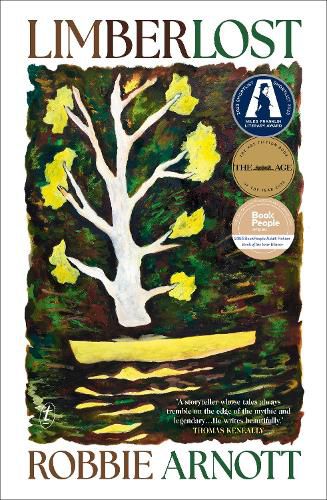 Robbie Arnott, Limberlost (Text Publishing)
Robbie Arnott, Limberlost (Text Publishing)
Reviewed by Carly-Jay Metcalfe
From the opening pages of Limberlost, I knew I was reading a novel so expertly crafted that it was going to shake me as both a reader and a writer. With imagery like, “Even in these early hours they leaked their summer oils, shimmering the air, thickening the light”, the skill of this book is writ large. It is easy to see how and why this novel is longlisted for the 2023 Miles Franklin Award.
The first chapter is a revelation and a masterclass in the economy of words. It begins with a Hemingway-esque fable of a whale that terrorises local fishermen, which captures a boy’s curiosity about the mythical creature that is so ebulliently alive in local folklore: “Have you waited, starlit and voiceless, for its heavy flukes to fall? In all your grey-green lives, have you ever known a terror like that?”.
Lashed to the loamy Tasmanian wilderness, Limberlost is a poignant imagining of the life of Ned. Born into the turmoil and uncertainty of 1940s war time, Ned is fifteen and leads a largely solitary existence while his two brothers are on the battlefront. Bearing the weight of responsibility as though he needs to occupy the space his two brothers have left, he has his father and sister to contend with at home. Ned’s days consist of hunting rabbits so he can make enough money to fulfil his dream of buying a boat. For a time, Ned keeps this dream a secret, imbuing the narrative with a vivid sense of longing for freedom and peace.
Ned is a taciturn character, who reflects more than he speaks, and this lends a fable-like peculiarity to the story, which unravels in a series of beautifully rendered vignettes. Limberlost is the apple orchard Ned lives on, and the novel moves effortlessly between this one adolescent summer, and the varying stages of life – a tender and stirring portrait of a young man that captures the minutiae of farm life. It’s a deeply immersive reading experience and one that I did not want to leave whenever I had to put the book down to tend to the minutiae of my own life.
Arnott’s writing is wounding in the best possible way, yet the book doesn’t overreach in its scope, never straying from the Tasmanian wilderness. There is both a tenderness and brutality to Ned’s internal monologue when Arnott details the dismantling of the rabbits, which reinforces the intersection of human and non-human worlds. Ned is both healed and traumatised by nature; while trapping and skinning rabbits makes him feel a sense of contrition, what truly haunts Ned for the rest of his life, is the quoll he accidentally traps. This small yet incendiary beast holds a liminal space in the story and affirms how nature can heal humans: “Its rich brown fur, shining in the dawn, was splashed all over with bright cream-coloured spots.”
It's a slow burn of a novel with the prose lulling the reader into an almost meditative state. At its core, Limberlost is a rumination on the perilous nature of the wilderness, touching on the impact of colonialism on the land and its people. It’s also a staid examination of Australian masculinity. Arnott is a master of dialogue, and while it may be sparse, there is a vividness where not a word is wasted. Being immersed in Ned’s almost dreamlike world was a welcome reprieve from the rapid-fire time we live in, and his story, braided with lore, wended its way into my bones.
Limberlost is Arnott’s third novel and is far more conventional than his first two works, Flames and The Rain Heron (longlisted and shortlisted for the Miles Franklin, respectively). Limberlost might lack the more mythical qualities of Arnott’s other books, but the story of Ned gently simmers with a primitivism that is haunting until the final sentence. He is clearly an instinctual writer; his talent is on full display as he balances the absence of precocity with passages that pulse with a quiet effervescence.
Would I go as far as to declare that Arnott is Tasmania’s Tim Winton? Yes, I would, and I am willing to die on that hill. Limberlost is a superb rendering of a coming-of-age story. Tender, evocative, brutal and radiant.
Cold Enough for Snow
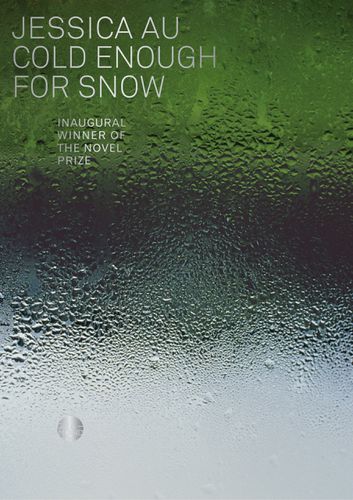 Jessica Au, Cold Enough for Snow (Giramondo Publishing)
Jessica Au, Cold Enough for Snow (Giramondo Publishing)
Reviewed by Professor Anna Johnston
A woman takes her aging mother to Japan in Jessica Au’s second novel. The mother was born in Hong Kong: she has never been to Japan, despite reading a book of Japanese fables to her children decades before. Her Australian-born daughter insists on their journey as something like a rite of passage for their adult relationship. There they will both be strangers, she decides. They are absorbed in both the sublime—galleries, museums, temples—and the quotidian aspects of travel: hotel bookings, lost passports, public transport, and the shape and size of luggage. On their last morning, the mother asks about her daughter’s work as a writer. In a characteristically circumlocutory way, the daughter answers by first talking about art—how a trained observer could identify a pentimento in old paintings. This is when an artist painted over an earlier image: perhaps only an object or colour had been changed, or a major visual component. “I said that in this way too, writing was just like painting. It was only in this way that one could go back and change the past, to make things not as they were, but as we wished they had been, or rather as we saw it. I said, for this reason, it was better for her not to trust anything she read”.
Au’s pentimento about art and memory captures the simultaneously lucid and allusive tone of this short novel (only 144 pages long). Things represented are both exactly as they seem on the surface and suggestive of great depths. Urban landscapes are vividly drawn: the smells, textures, and sounds of Ueno, Hibiya, Aoyama, and Roppongi evoke Tokyo streets. Yet when the narrator is filmed by her mother walking the busy Shibuya crossing, the narrator and the reader remain equally unsure of why these familiar sights matter. What meaning can they have now in an endless chain of reproduced images? Perhaps it is, indeed, wise not to trust anything we read–or see–in this postmodern world.
Elsewhere, the novel evokes modernist epiphanies. The narrator reminisces about her university days, her first job, her first boyfriend. A regular swimming practice was an important part of her strict self-regulation as a student. Leaving the pool, her world transformed: “I felt myself in an instant, the world opening up as through a great funnel, going from my feet to the leaves to the sky above. In those moments I thought of nothing, or if I thought at all it was unnameable. These moments never lasted; they were gone as quickly as they had come, so quickly I could never be sure that they had even happened”. Similar experiences take place on her solitary hike outside Osaka, where she “disappeared in and out of the forest like a character in a book”. But rather than memories, a sad foreshadowing colours an imagined future scene in her mother’s flat after her death: “I thought of all the things I would find there – private things like jewellery, photo albums, and letters, but also signs of a careful and well-organised life …. In the end, I knew I would keep nothing, whether out of too much, or too little sentiment, I did not know”.
The novel’s elliptical tone plays constantly with time and memory. How much we can know another person, even those as intimately connected as mother and daughter, haunts the book, as does how much we can know our (past, present, future) self. The gentle familiarity of the travelling pair is rendered poignant by the sense of impending loss, a proleptic elegy that makes the journey dreamlike in its shifting temporal settings. We also wonder whether the mother is a real presence, or a mere projection of the daughter’s desires. Perhaps she is only ever talking to herself? We rarely hear the mother’s voice. The mother’s only interest in travel is her query whether Japan will be “cold enough for snow, which she had never seen”. Even though her presence can appear miasmic, this evocative phrase provides the novel’s title. Like the Monet paintings they visit, the world shown is all “questions and dreams, which were, like always, better than reality and thus unendingly fascinating”. The mother’s childhood in Hong Kong is conflated with the daughter’s own memory. Whether or not she and her partner Laurie should become parents is another recurring contemplation, a possibility “as lovely and elusive as a poem”. She reflects that if she, too, has a daughter, that child would live as part of her: “her memories would be my memories, and she would have no choice in the matter”. Yet memories are fragile. The daughter can only remember two Japanese fables: one in which a young woman dies in the snow, and another about an ill-fated love between mountains that creates a destructive volcano.
Au’s book won the Novel Prize, an award for literary fiction that seeks out formal innovation and, alongside a cash prize, offers the winner simultaneous publication in Australia, New Zealand, the United Kingdom and Ireland, and the United States. This is both an Australian and a global story for the Miles Franklin judges to consider: a stipulation of Miles Franklin’s will that has troubled past juries.
Au’s elegant, suggestive writing no doubt secured this inaugural prize, and the book has since won several other awards. It is unsurprising that this novel has made many shortlists, for it rewards re-reading. Nor is it surprising that this book emerges from Giramondo Publishing, under the guidance of Ivor Indyk. Au’s Cold Enough for Snow subtly skewers racial and gendered stereotypes—the renowned Australian restaurant that requires a sense of formality to create its “floating world”, and asks its all-female staff to dress demurely with a small mandarin collar: “just enough to give a vague sense of what was once referred to as the Far East”. New Australian fiction, especially from the second- and third-generation diasporic communities of Western Sydney, is quietly but determinedly shattering the white male ceiling of Australian literature, as Maxine Beneba Clarke notes elsewhere, creating a provincial literature that is both local and global in scale.
Chai Time at Cinnamon Gardens
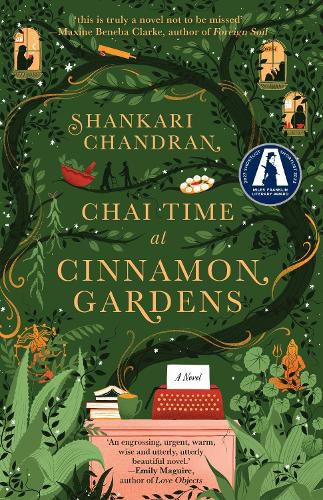 Shankari Chandran, Chai Time at Cinnamon Gardens (Ultimo Press)
Shankari Chandran, Chai Time at Cinnamon Gardens (Ultimo Press)
Reviewed by Olivia De Zilva
What does it mean to be Australian in the 21st century? Shankari Chandran’s Miles Franklin shortlisted novel Chai Time At Cinnamon Gardens ponders this question with grace, humility, and confronting depictions of racism raging with Shakespearean levels of drama and tragedy.
The beginning chapters of this sprawling tale open at the Cinnamon Gardens Nursing Home nestled in Sydney’s multicultural suburb of Westmead. The nursing home is a sanctuary for quirky and culturally diverse seniors and is initially run by Maya and Zakhir . The family, including their daughter, Anjali,escaped the turmoil of the Sri Lankan civil war some 20 years ago. Finding solace and a new purpose in a dilapidated nursing home on the brink of closing, Zakhir and Maya breathe new life into it, changing its name, painting the stark-white hospital walls over with warm hints of turmeric yellow and removing a bronze statue of Captain James Cook to make room for a traditional and holy Sri Lankan garden. Interweaved with intergenerational trauma, violence and harrowing grief (with Cinnamon Gardens merely as a backdrop) across different timelines, Chandran traverses decades and oceans, war and death, to tell the story of the characters who have passed through the doors of this much-loved family establishment.
When Anjali takes over the business from her parents (Maya has since retired and Zakhir has gone missing under mysterious circumstances), life, at least from the outside, is as tranquil as the eponymous nursing home suggests. However, when Reuben, an employee with a mysterious backstory left in Sri Lanka, is racially attacked by faceless goons in the middle of the night, the looming threat of violence and tragedy comes closer and closer to the gates of Cinnamon Gardens. Amongst this, Nicki’s (Anjali’s best friend and employee) strained marriage to local councillor Gareth comes to a fiery head, setting off a tragic turn of events that will affect the lives of those around them to devastating effect.
There is no denying that Chandran is a stunning writer. Her cultural critique and sympathy for these characters allow the reader to fully immerse themselves in a world that is both familiar and darkly tragic. The work is full of rich and lavish vignettes that ask the reader to question and consider ideas of family, home and displacement. While I was reading this, I never once felt idle and was fully engrossed in Chandran’s immersive world that never spared any punches when it came to exposing the current state of Australian society. Chandran’s background as a lawyer shines through as she writes, without hesitation, about the damning injustices and cruelty hurled towards migrants by the Australian legal system. While she juggles these different, but altogether complex issues, in 350 pages, Chandran’s story only detracts in minor instances when the author has become too overambitious in the amount of drama she injects into the lives of these characters.
At times, it felt like there was not a moment’s rest for the residents of Cinnamon Gardens. Amongst racially aggravated attacks, divorce, torture, death, domestic violence and internet cancelling, the characters’ lives veered towards melodrama, so the thread of reliability and comfort Chandran worked hard to weave becomes frayed. At times, the characters become overshadowed by the darkness that surrounds them, and it is difficult to see them as everyday people when they are written as complex case studies. The different perspectives of this book, similar to Christos Tsiolkas’s Miles Franklin shortlisted triumph The Slap (2008), sometimes risk becoming convoluted and difficult to understand amongst the vast backdrop of this often harrowing and complicated tale. Chandran is obviously passionate about representing the events of the book as naturalistic and accurately as possible, and while she does achieve this on some occasions, the sincerity and subtly needed to connect to readers in the darker moments of the story become too engrossed in theatrics and spectacle to make any real impact. Many times, I needed room to breathe and reflect during reading. The plethora of tragedy and sadness could often become overwhelming, so had Chandran been less-ambitious with the scale of the work, there would be more room for connection and understanding with the world she presented (both past and present).
Chai Time at Cinnamon Gardens is an important and enthralling read. While it lacks subtlety on some occasions, the message it evokes is damningly clear. Like most contemporary Australian stories, it begs us to question the complexity and terminal impact of racism and the damage it has caused across generations. Its inclusion in the 2023 Miles Franklin Shortlist illustrates the importance and ongoing efforts of reclaiming the Australian story away from the white hegemonic gaze and as something that can be shared by a variety of voices (much like a good cup of chai). Shankari Chandran’s passion and tenacity to uncover ugly truths, discover beautiful secrets and expose the reader to the obvious and very real threat of racism is what makes her novel one of the most important and alarming stories on Australian bookshelves.
Enclave
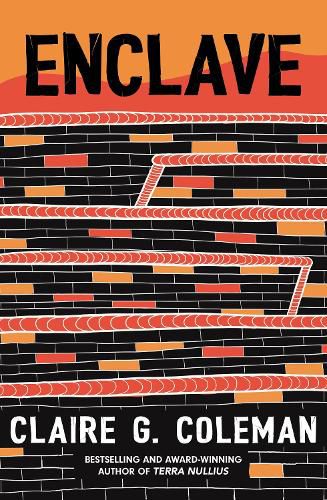 Claire G. Coleman, Enclave (Hachette Australia)
Claire G. Coleman, Enclave (Hachette Australia)
Reviewed by Dr. Natalie Collie
Few works of speculative fiction have been considered for Australia’s most prestigious literary award, a symptom of the genre’s uneasy relationship to literary fiction and culture. Here “speculative” designates a range of genres – including science fiction, horror, and fantasy – that stretch their fictional worlds beyond what would normally be considered “real” or even probable. In so doing, these stories explore truths of lived experience that realist literature can struggle to articulate. What truths, then, does the world of Enclave offer its readers?
Noongar author Claire G. Coleman’s parable of two cities is set in a future south-east Australia of extreme temperatures and civil unrest. The first city, Safetown, is a high-tech utopia walled off from an outside world of environmental and social chaos. The book’s protagonist Christine is listless and lonely, and increasingly uneasy with the apparent luxury and safety offered by her walled city and the Agency that runs it. Security vans, cameras and drones are everywhere she looks, always watching. The news is full of images of the violence and crime beyond the city: ‘of the bad people and dangerous criminals being kept outside the city Wall; of terrorists threatening her life, buildings falling, people dying’. Inside, her family lives a life of immense wealth and privilege. Servants – dark-skinned and bused in each day from outside – work unobtrusively to meet their every need. Safetynet, the city’s sophisticated online network, anticipates their every desire. Everyone lives in near identical houses. Christine’s mother and her friends all sport near identical facelifts and drink inordinate amounts of alcohol. Everything feels staged, a city of harshly lit and artificial surfaces.
The first half of the book may seem a little slow, frustrating some readers. There is a logic to this pacing, however. A place that is too perfect to be real is claustrophobic and monotonous. And to awake from this all-encompassing dream takes time. Coleman crafts a slow build of paranoia and tension; it happens by accretion, barely noticeable for the somewhat clueless protagonist. And then all at once, time accelerates into furious action.
Safetown is revealed to have been dystopian all along for anyone excluded or exploited by its ruling class, an homogenous society of heterosexual white people. Therein lies one of Enclave’s most important lessons: utopia, in the strict sense, is not a good place but a no-place, an impossibility. As Coleman has noted elsewhere, “every utopia also has an underclass because if everybody has to do their own dishes and take out their own rubbish, that's not a utopia… every utopia is a dystopia, every dystopia is a utopia.”
The kiss that fully awakens our protagonist breaks lines of colour, class, and sexuality. Caught by ever-present surveillance cameras, Christine’s transgression leads to her arrest and eventual expulsion beyond the safety of the city’s Wall. Now a refugee, she must survive an apocalyptic wasteland before finally finding refuge in Enclave’s second city, an environmentally sustainable and socially diverse future Melbourne.
Here Coleman presents an alternative future, one that does not rely on fear of the other, mindless consumerism, or ubiquitous surveillance. Future Melbourne is a queer and postcolonial utopia that Christine struggles to understand: “Nobody looked poor, nobody looked angry or sad or lost, faces held a lightness she had never seen before; she didn’t know how to read it.”
In this version of a future Melbourne – with universal income, free education, gay marriage, and free people of every colour – Enclave offers a cautiously optimistic Indigenous futurism that may be too romantic for some readers, given the earlier lessen in utopia’s impossibility. However, taken together, Safetown and Melbourne’s differences provide a stark critique of contemporary Australian society: the opposing socio-economic and political forces at war over how we understand our past, experience our present, and imagine our future.
With this novel, then, Coleman continues to demonstrate the power of speculative worldbuilding for First Nations writers – alongside works such as Alexis Wright’s The Swan, Ellen van Neerven’s Heat and Light, and the recent anthology This All Come Back Now. In addition to its literary merits, Enclave is concerned with decolonising Australia’s stories about itself and its future. In the process, the unexamined racism still driving speculative fiction’s narratives of empire, progress, or pastoral idyll are also decolonised.
In a recent interview, Noongar author Claire G. Coleman suggests that her work is best understood as ‘literary speculative fiction’. Good speculative fiction juggles several different imperatives that can conflict in unskilled hands. Political sub-text – the didactic power of the parable – must be balanced by believable, genre-savvy worldbuilding. Without committing to both, the author risks losing their reader’s immersion and willingness to complete the story. To write ‘literary’ speculative fiction, however, adds a third demand: to write the kind of fiction that might be considered for a literary prize such as the Miles Franklin. Enclave’s nomination indicates the author’s ability to juggle all three imperatives with creativity and skill.
Losing Face
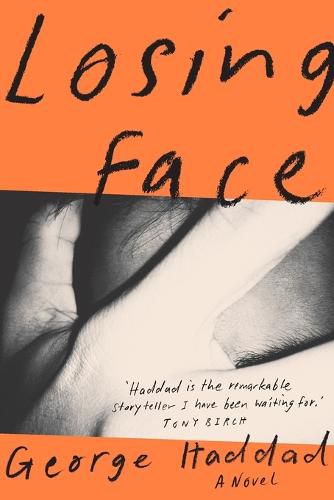 George Haddad, Losing Face (University of Queensland Press)
George Haddad, Losing Face (University of Queensland Press)
Reviewed by Pierce Wilcox
Who would nominate this? A novel about a terrible man, who does a terrible thing, in the year of Greta Gerwig’s Barbie? Wasn’t the entire past century of literature enough?
George Haddad’s debut novel Losing Face is pitched to invite these questions. For the most part, though, this isn’t a novel about consent. It’s the story of a young man trying to figure out who he is and failing in every way except the one that matters, and of his grandmother, fascinatingly ignored by most commentators in much the same way she escapes notice in the novel itself.
At nineteen, Joey is not a boy, not yet a man. He lives in-between: with a Lebanese mother and an absent Anglo father, he’s neither fully “ethnic” nor accepted as “Aussie”. He hangs with friends he doesn’t particularly like and attends parties he doesn’t particularly enjoy. He’s a quiet witness, Christopher Isherwood of I Am A Camera reborn in Western Sydney.
A disinterested protagonist succeeds on the strength of their observations. Esther in The Bell Jar speaks through an anhedonic fog, and her lines still crackle with precision; in their close third-person perspective, Joey’s chapters are closer to the flatly readable prose of a YA novel. At its best, the mundane specificity of Joey’s world rises into a startling, almost dissociative insight, as when his furious mother speaks with “Home and Away calm’”, but these come rarely.
Haddad seems liberated when he steps beyond Joey. The novel alternates chapters between Joey and grandmother Elaine, a widow with a secret addiction to the pokies. Elaine’s chapters surge with a sickly, near-erotic twinning of thrill and shame as Haddad perfectly captures the garish seductions of the gaming lounge, and Elaine’s swings between cynical judgement and wild optimism provide a great contrast with Joey’s prelapsarian ambivalence. It’s a thrill to witness his control of tone: Elaine’s scrambles to hide her habit threaten to slip into melodrama or farce, and Haddad never lets them beyond the small sadness of the real.
The same doesn’t go for the book’s pivotal tragedy. On a night out with his mates, Joey watches the swaggering Boxer pick up a girl, Lisa, on a train and talk her into joining them. Boxer pressures Joey and Lisa into taking laced ketamine, and as the drugs hit, Boxer and his friend Haz manipulate a barely-conscious Lisa into sex. Joey is pushed to join in until he vomits and stumbles back into the role of witness.
It’s a nightmarishly memorable scene. Joey’s drug mix grants him a surreal, elevated vision. He sees the others as archetypes in a play, in front of two-dimensional sets, while he is merely a “stagehand in the pantomime”.
It’s also a misstep. This kind of dizzying lyricism belongs to a Pynchon set piece or a Philip K. Dick antihero. For a novel that works so hard to put us in Joey’s head, this jolts us out at the moment when his voice matters most. Ketamine turns Joey into a theatre student; I am a theatre student, and if I hypothetically ever took it, ketamine would make me say “this is so not disco” fifteen to twenty times and then lie on the floor.
This is Haddad writing beautifully, not Joey speaking. Neither is it Joey participating. The drug trip places a screen between reader and event. It also exculpates Joey for the crime.
It’s a cop-out for a novel that wants to confront real life. Haddad takes an event that resembles the shocking Skaf gang rapes of the early 2000s and changes the details to keep his protagonist relatable. Joey is a bystander, one who should have acted and knows it, but the drugs rendered him insensible. When Lisa goes to the police, his family and friends are appalled – but everyone goes on to say and do the right things.
The last third of the novel becomes a recurring series of scenes where a character confronts Joey, he admits he should have stopped the rape, someone worries about Lisa’s welfare, and then everyone insists that they shouldn’t make her pain about him, and reassures each other that although Joey’s learned from her suffering, Lisa’s is the story that matters. This doesn’t feel like an authentic narrative. It feels like a teachable moment.
A braver, messier novel would be willing to delve into the loathsome Boxer’s psyche, or let Joey become a perpetrator and then find a way for him to work towards rehabilitation, if not forgiveness. Instead, Boxer vanishes from the narrative, and he’s left as simply a monster. In his place, the novel might at least give us Lisa. There's a moral paradox in insisting the survivor's story is more important, then refusing to share it. It's like Haddad is daring us to imagine a better book.
The final point in Joey’s special pleading is that he is, as he slowly discovers, queer. Across the novel’s most tender chapters, Joey fumbles towards a shy romance with Ivan, who he meets at an EDM festival. There’s no explicit coming-out, no grand revelation, which feels right. Joey isn’t the type. Instead, there’s a subtle rapture in watching this eternal watcher make the tiny, huge decision to lean in for a kiss.
All of this falls by the wayside when the rape case takes over the novel. There’s deliberate skill in Haddad’s construction. Joey’s early meandering and flickers of growth gain pathos in retrospect: this is an interrupted bildungsroman, a life that refuses to follow novelistic patterns.
Except desire has its own gravity. Joey and Ivan reconnect at the end of the novel as if nothing had happened, and there’s a vision of a different story, where nothing ever did.
Ivan and Joey’s romance is what makes this an understated, lovely book with an episode of Special Victims Unit wedged inside. It’s the unusual parts of Losing Face that make it a remarkable Australian novel, not the parts ripped from the headlines.
A Western Sydney grandma careening through addiction and still finding time to dress down her family. A half-Lebanese, half-Anglo kid realising the one identity he might fully own is that he’s someone falling in love with a man.
Forty Nights
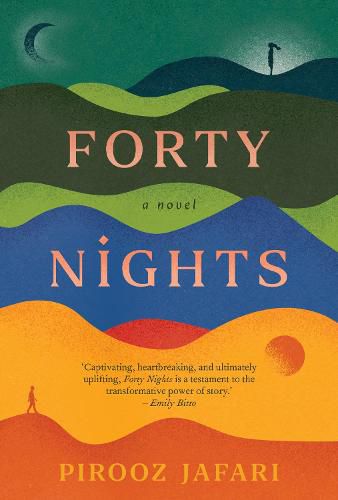 Pirooz Jafari, Forty Nights (Ultimo Press)
Pirooz Jafari, Forty Nights (Ultimo Press)
Reviewed by Martine Kropkowski
Persian New Year in Iran sparks the celebration of Chaharshanbe Soori, an ancient custom that heralds the beginning of spring. In Tehran, the holiday begins with the lighting of small fires, fuelled by stacks of kindling heaped at one-metre intervals up and down neighbourhood streets. Throughout the night, people take turns jumping the fires, chanting Your redness be mine and my paleness yours as they leap, exchanging their ailments for the fires’ warmth and glow. While the fires dwindle, children rush from door to door, knocking to receive small packages of nuts to add to their bounty.
On a hot early-autumn night in the southern hemisphere, Iranian-born Tishtar checks his social media feed: Melbourne’s Chaharshanbe Soori celebrations will be cancelled this year; the temperature has reached thirty-five degrees all week and the risk of bushfire is high. He recalls his youth, sitting on the driveway in Tehran, fires smouldering around him. He remembers the smell of woodsmoke, the sound of firecrackers exploding near and far, the sight of the Alborz Mountain range covered in snow on the horizon.
“If someone had told me that as an adult I would have been celebrating Chaharshanbe on the other side of the world, I would never have believed them.”
Forty Nights is a debut work of literary fiction by Pirooz Jafari, who has fictionalised his own life story in this novel. It opens with Tishtar’s adult life in Melbourne. He’s a human-rights lawyer working to help his friend Habiba. Her orphaned nieces are living at great risk in Somalia, and she is trying desperately to move them to Australia.
Tishtar contemplates the refugee and family reunion cases he has handled over the years:
“The more tales I’ve heard, the more I’ve come to realise how much us migrants all have in common. Always on the outside looking in—no longer part of the life we have left behind, not quite belonging to the new-found soil.”
Often, Tishtar longs for home, for the waft of pomegranate molasses simmering in the kitchen, for the sharing of mixed nuts and watermelon with his loved ones, for summer holidays by the Caspian Sea. Now, he listens intently over the phone to his mother, reciting verses from Divan-e Hafez—a collection of Persian poems from the fourteenth century—but it’s not the same as sharing space.
This home Tishtar remembers is only one version. Another version features the violence of war. It includes his mother’s decision to retire at 45 rather than wear a hijab to work and her subsequent descent into depression. It involves his young friend being arrested on her walk home from school, imprisoned and killed that same day. It involves the dread and terror of the Revolutionary Guards, catching him studying from a western book at university and eventually prompting his emigration away from his beloved home.
The narrative toggles between Tishtar’s life in Melbourne, his time growing up in Iran, and a third narrative thread set in fourteenth century Gotland, which depicts the invasion of the Swedish island by the Danes.
Threads of dispossession and dislocation connect these narratives, which Jafari has presented in parallel to illustrate the legacy of colonialism and displacement and the reconfiguring of what home, ritual, and culture mean for migrants trying to strike roots in unfamiliar soil. Tishtar often ruminates over the adaptability of culture, at one point remarking to Habiba: “It is fascinating how invasion has influenced cultures time and time again.” She is not so philosophical, replying: “Change in our way of cooking is nothing when our people have been running for safety for decades.”
Forty Nights joins a tradition of literary works, including No Friend But the Mountains by Behrouz Boochani (Pan Macmillan Australia, 2018), The Permanent Resident by Roanna Gonsalves (UWAP, 2016) and The Tribe by Michael Mohammed Ahmad (Giramondo, 2014), whose narratives of dislocated peoples offer frank and insightful insider accounts of the contemporary migrant experience in Australia.
Forty Nights is published by Ultimo Press, notably over-represented in the long- and shortlist of the Miles Franklin Award this year. With a goal of discovering “original perspectives that reflect the full spectrum of Australian life”, Ultimo seems to have tapped into the stories about contemporary Australia that we want to hear.
And it’s little wonder, after decades of Australian Government rhetoric dehumanising “boat people” and the 2019 African gang panic in Victoria, that Jafari’s novel has captured the judges’ attention. If it falls to the novelist to counter sustained harmful rhetoric targeted at the Australian immigrant, Jafari has presented a powerful counter narrative in Forty Nights, a novel delivered with heart and heartbreak that raises questions about what comprises a home, what comprises a self and how we might start again in a new place after leaving everything behind.
In the novel, Tishtar and his family stop lighting fires for Chaharshanbe Soori when Iraq invades Iran. Jafari writes: “We were told that [lighting fires] had been banned to make sure that we didn’t light the path of Iraqi planes, but in hindsight it was also likely the regime’s way of eradicating an old Persian tradition.” In this fictional rendering of his life, Jafari invites us to consider the repeated patterns of history—to remember our great sorrows, our wistful joys, the rituals we practise and the people we practise them alongside—so that we might meld all of those things into a future that celebrates the differences in our cultures just as much as the experiences we have in common.
Insightful, tender and whimsical, Forty Nights is a standout novel on this year’s longlist.
Madukka The River Serpent
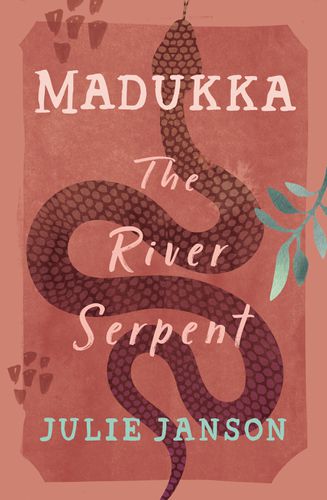 Julie Janson, Madukka The River Serpent (UWA Publishing)
Julie Janson, Madukka The River Serpent (UWA Publishing)
Reviewed by Rani Tesiram
“Aunty June is the proud owner of a TAFE certificate III in Investigative Services. It took her thirty hours to complete online. Now, she has set up her own private investigation service: Yanakirri Investigative Services – Confidentiality Guaranteed.”
These first few sentences from the blurb for Madukka The River Serpent had me absolutely hooked. It suggested a Blak Golden Girls-esque take on Australian Crime Thriller. I was excited by the prospect of what Aunty June could get up to while she investigated the disappearance of local environment activist Thommo. There was great potential for Outback small-town and hilarity that comes from the mixing pot of regional characters. Much like AusPost, it did not really deliver.
Janson’s initial plot does pull you in. It’s full of so much promise. Thommo, a local activist mysteriously disappears after a protest and the police don’t seem to care. Early on, there is some suggestion they might be involved, but Aunt June doesn’t follow up this clue. I’ll put in a warning here that there is a sexual assault scene early on, but the string of events left me confused. Janson seems to be writing from an omniscient point of view, but she rarely reveals what the characters are thinking and their motivations for their actions. This may potentially be a holdover from her background in playwriting that doesn’t translate as well to the form of the novel. Characters that would have been clever, compelling, and rife with plot potential ended flatter than they may have been otherwise. They seem to be making decisions with no loyalty to themselves or their environment.
Janson’s delivery of a potentially compelling crime mystery/thriller was inconsistent and left me deeply displeased. At times, beautifully detailed descriptions were lost in the slow pacing and jumbled dialogue. Take this example of dialogue from Chapter 6 when young lawyer Steve comes to visit Aunty June at her office and discuss the disappearance of Thommo. Steve offers some assistance and then he continues the conversation while wandering around Aunty’s office:
“‘Is it okay if I take a photo? I can study the suspects for you and ask a few people I know in the police in Sydney. I have some mates who are detectives.’
‘Don’t tell Uncle Jack,’ said June.
‘My true reason for coming is to take Arana to the ball. That’s the way to a young woman’s heart, eh? I’ve never been to a ball.’
‘She’s dying to wear that dress.’ [no dress has been mentioned before this]
‘I’ve written an article or two about climate change and the disaster of the Darling River. There’re a lot of Indigenous activists in the city, and we work alongside some major climate strategy services. We have articles in major online news feeds. The times are changing; we can help you up here.’
‘You got some smart ideas, that’s for sure.’
‘And we have a TV crew…’”
This awkward dialogue broke up a narrative full of exposition. This scene would have been easier to follow if the characters’ actions were present. At no point does Janson tell us what they are doing. Instead, the dialogue is presented as a “Speaker A” to “Speaker B” cut back and forth. I again attribute this to Janson’s background as a playwright but this isn’t a play and as a reader I need more to immerse me in the scene.
I mentioned the beautiful imagery I encountered while reading and I’d like to take a moment to appreciate the opening paragraph of Madukka.
“A crow picking at eye sockets in a sheep skull was a reminder of how outback country towns were shrivelling up. A desert landscape shone red and grey against the Darling River. The dusty desolation of Ngiyampaa country. Benevolent colonialism. A town beside a stinking green river of dead fish. The ash-filled streets smelt of bushfire, the air heady with barbequed animals. A town where most of the shops had iron-mesh grilles, chains and big locks.”
Janson builds a wonderful picture of the area of Australia this story is taking place: the dichotomy of the lush green and death. I knew what dirt I would be standing on. These are the moments of Janson’s writing that kept me reading. I could gloss over flaws in the text just to be on Country.
I pushed on. As a Wiradjuri person myself, I was invested in seeing how Janson dealt with the racism she had her characters endure. Admittedly, I did not grow up in rural/regional Australia and so I’m generally unfamiliar with what that life is like, but I have not once seen an “emu cage” in my travels of regional Australia—paddocks yes, cages, no.
From time to time, Janson’s explanation of certain language or culturally significant places felt like it was written for the white reader. It felt almost patronising to read. “National Aboriginal and Islander Day Observance Committee week” could have easily been shortened to “NAIDOC week”.
Despite these criticisms, Janson’s portrayal of the fight for environmental conservation and against climate change resonated with me. It was easy to side with everyone’s concern for the conservation of the river and against the cotton fields. This fight for the land and caring for it is a fight I’ve grown accustomed to hearing about and fighting in Australia. I would have loved to have seen this theme expanded.
While at times I struggled to understand how Janson’s first foray into crime writing had qualified for the longlist of the Miles Franklin, Madukka’s handling of issues of racism, climate change, drug use, and the ongoing First Nations’ struggle for land back and recognition ultimately makes it worthwhile. I’ll end with my initial thought; I actually think I’d really enjoy seeing this story adapted for the screen. Maybe, I just want an excuse to see more of the Outback.
The Lovers
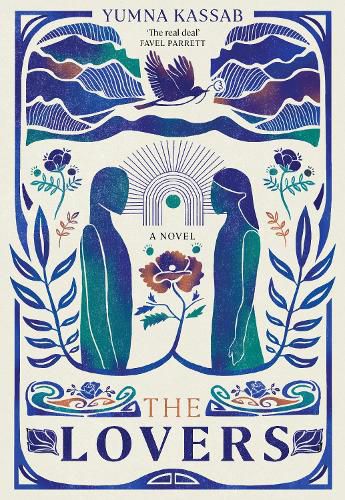 Yumna Kassab, The Lovers (Ultimo Press)
Yumna Kassab, The Lovers (Ultimo Press)
Reviewed by Bianca Millroy
“Can we ever have enough of love?
At what point does one abandon the boat for a future unseen?
Are these even legitimate questions?”
I came to The Lovers with the expectation that I would be traversing similar terrain to that of Alain de Botton’s The Course of Love (2016). Everything I’d read about this Miles Franklin contender skimmed the surface of its multifaceted narrative, focusing on the stylistic mechanics and emotional affect rather than digging deeper to dissect the heart. I expected a modern fable underscored by Arabic folklore with more traditional, less didactic conventions. What I found instead was something far more poignant, raw and real.
The Lovers (Ultimo Press, 2022) is the third novel by Australian author Yumna Kassab, following Australiana (2022) and The House of Youssef (2019). But perhaps a better way to begin (and by that I mean convince you of its merits as the Miles Franklin judging panel have evidently been convinced) is to tell you the story of Jamila and Amir.
“What Amir loved most about Jamila was that she smelled of money…” is one of the most startling and transparent opening lines I have come across. Whatever your experience with love, be it lucky or not, this one will resonate. But this, I would argue, is not a love story. And despite the thematic threads binding the lovers to lore, this is no fairytale either. As the blurb poses: “This is a story you might think you know. Maybe you do…”.
I cannot promise a taut and gripping plot, nor redeemable characters or a wholly satisfying outcome, but I can promise a story about love and what it means to be together. When one enters willingly into a relationship, or marriage, who is to say it will survive ‘til death do us part’. Indeed, for our titular lovers, the course of love is a path strewn with roses and thorns…but also growth. This is a story about the power of dreams and the fallibility of memory. Of ownership and accountability. But, most of all, it is about living honestly.
“When passion and desire fade, do we go looking for colour in our lives?” Kassab weaves a kaleidoscopic web, light to dark, throughout the story of Jamila and Amir. This is the true ‘universal’ experience of what it is to love, and be loved. Or, perhaps, this is the breaking of the proverbial iceberg: what you thought you knew about love or about yourself. Below the surface, it is an allegory for two world-weary souls teetering on the edge of despair. The effect of its denouement was, in order: frustration, sadness, inevitability.
The book asks the reader to contemplate love through the eyes of these flawed lovers, not in a romantic, rose-tinted sense, but to reckon with the hard truth, the “tough love” after ‘Happily Ever After’. Humour, irony, allegory, metaphor go hand-in-hand as Kassab guides us through a series of episodic, interconnected vignettes, shedding light on the choices they make, the paths they take, and the rules they break. Because let’s face it: no-one’s perfect.
One of the most distinctive facets of The Lovers is the book as an object itself: the tangible aesthetic of a hardcover book. The artwork is simple yet stunning, transportive and fable-like, which leaves me wondering: if I’d been gifted this book, or hadn’t been given a deadline in which to read it, would I have considered it anything more than a shiny new object for my coffee table? A spell of late-night armchair philosophy, or something to flick through seeking consolation after a lover’s tiff? Kassab clearly set out to experiment with form. ‘I care about taking risks,’ she says. Care and risk may seem at odds with one another.
But life is full of dualities, and The Lovers is no exception.
The chronology of the story defies logic, as does the structure. Although there isn’t a strong narrative pull, Kassab’s deceptively simple prose could compel even the most conservative reader to surrender to its fluid cadence. Curious about the story’s polyphonic quality, I also listened to the audiobook, and found the voices were more clearly delineated. This confirmed that the story can exist independently of its physical casing and still make its mark. For these reasons, I suggest two readings: as a parable of longing and a cure for dreamers and romantics alike. And as a manifesto for the unlucky-in-love. In the end, Kassab positions the reader to dwell not on the fate of the lovers but on all the wondrous and devastating possibilities of love, in every form, beyond the final page.
The Lovers is brimming with elusive, often rhetorical, questions. To return to the question of one having ‘enough’ of love, I quote Amir, “It is a question I pose with the awareness that there is no answer”. Does it matter then, if I am left reeling, questioning what I have just read? Does it matter if love prevails? These, in turn, raise another, more pertinent question: could this be the winner of the 2023 Miles Franklin? The coveted award, first presented in 1957, seeks to bestow the honour of ‘the highest literary merit’ depicting ‘Australian life in any of its phases’. There is no doubt The Lovers is a literary achievement and a work of great philosophy and beauty. Deftly weaving myth with metaphor, it achieves the richness and dimensionality the great novel requires without compromising on buoyancy and brevity.
Ultimately, Kassab has crafted a literary sleight of hand, a novel that is, by its very definition, a work of supreme innovation. Irrespective of whether The Lovers is the recipient of the 2023 Miles Franklin, its nomination speaks to the state and tenor of contemporary Australian literature embracing the novel as an experimental form. To invoke the book’s inscription: Let fate have its hand…and I, as its beholder, remain in awe of its presence.
Iris
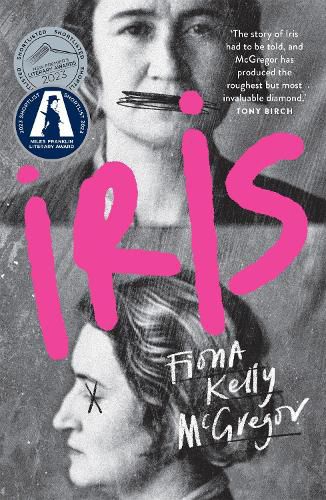 Fiona Kelly McGregor, Iris (Pan Macmillan Australia)
Fiona Kelly McGregor, Iris (Pan Macmillan Australia)
Reviewed by Madeleine Dale
The historic Iris Webber was once called “the most violent woman in Sydney”. A drug-runner, sly-grog slinger, thief, illegal busker, and maybe-murderer, she was deeply entrenched in Sydney's underworld during the thirties, forties, and fifties. However, this image of Webber – dangerous, criminal, violent – has been largely handed down by the police reports and sensationalist newsprint of the time. It’s a portrait with an agenda and one further obscured by disfiguring homophobia – Webber was known to have romantic relationships with women.
McGregor's Iris steals the story back. The woman contained within these pages is brash, brave, and deeply feeling. Her first line of direct narration is a correction to earlier police assumption: “In fact I came to Sydney in October 1932.” The story that follows is one told almost entirely in Iris's voice and on Iris's terms.
Arriving at Central Station with one dodged murder charge already under her belt, twenty-something Iris is quickly gathered up by Sydney's bleak underworld, as her story pinballs through the criminal empires of Tilly Devine and Kate Leigh, the suffocation of respectable Glebe, and the wracking deprivations of the Depression. Always at the forefront of this narrative, however, are the people in Iris’s orbit – the working girls she shares a strained camaraderie with, the men who betray and befriend her, and the woman she loves.
All historical fiction must contend with the reality of its subject, but Iris manages this dance more deftly (and more compellingly) than most. Iris’s distinctive narratorial voice commands the story in a breakneck, vernacular first person which masterfully transforms McGregor's impressive research into seamless and offhand personal knowledge. It’s a wonderful way to be told a tale–rather akin to sitting by the fire with a favourite and somewhat wild aunt.
This darting, personal voice also presents a remarkable negotiation with the past–and with the ‘real’ Webber. Often, Iris feels more like an oral history than a novel, and this mode of narration holds space for exaggeration, misunderstanding, and opinion. McGregor’s Iris tells one version of her story; how much of it we believe, how much of it is ‘true’, remains an open question.
The elusivity of authenticity is brought into clearer focus by a series of interstitial chapters, which follow Iris through her trial for murder in 1937. Here, narration switches to an omnipresent third; suddenly, we see Iris through the eyes of the law and its officers, and the contrast is jarring. This is not, however, a retreat to impartiality. The sober, historic tone of these interludes is instead complicated by McGregor’s inclusion (in the book’s opening pages) of Webber's actual police record and the use of Webber's mugshot on the cover.
On the one hand, these fragments seem to represent a concrete reality which renders the trial chapters just another layer of fiction. Equally, though, such records capture an institutionalised view of Iris, the accuracy of which McGregor constantly undermines. In the end, there are no easy answers or uncontested ground here–instead, questions of veracity and history, and of erasure and reclamation, continue to echo.
Such is the delicate machinery that underpins Iris and gives the novel much of its innovation and intellectual heft. However, the story these cogs drive forwards is, it must be said, a rollicking good read. The danger, heartbreak, and excitement of Iris’s life whip the reader through the longest book on this year’s Miles Franklin shortlist. A huge cast of characters flash in and out of frame while 1930s Sydney blooms with the brightness and immediacy of a blood stain.
Given this, it is tempting to describe Iris in terms such as sweeping or epic – a more accurate word, however, might be intimate. For all its scope, this remains the story of one woman and her personal world. It’s this intimacy that lifts McGregor above easy cliches of underworld violence and glamour, and into an arresting portrayal of a community under siege.
Iris and her contemporaries are ground beneath the heel of poverty, bigotry and the NSW Police Force–the latter often literally. They are arrested and brutalised with exhausting frequency, largely for trivial offences; Iris herself is taken up, repeatedly and violently, for busking. The charge seems laughable to a modern audience, but, for Iris, it falls under the offence of ‘gather alms’. Or, more simply, the crime of being poor in public. That Iris is later arrested for shooting a man does not seem to rebalance these appalling scales of justice.
Iris's treatment by the cops, by her community, and, indeed, by the historical record, is further informed by her queerness. While her slow feeling out of her own identity is at times awkward and nebulous, McGregor returns a dignity and undeniable presence to this facet of Iris’s life. Similarly, the vibrant glimpses we are afforded of Sydney's historic queer community form one of the most uncomplicatedly sympathetic aspects of the book. And, in a world currently weathering a resurgent wave of anti-queer and anti-trans rhetoric, this affirmation of place and history feels critical. Here again, McGregor performs the delicate work of excavating Iris Webber from an often hostile archive and setting her–vibrant, complex and compelling–onto the page.
The violence inflicted on and by these characters (a violence which falls far more heavily upon those experiencing multiple marginalisations) does not feel like a historic relic. Instead, McGregor's depiction seems a vital and urgent addition to our understanding of continuing patterns of misogyny, racism, and homophobia, of police violence, and criminalisation.
The blurb of this book asks a simple question: is Iris Webber innocent or guilty? At the end of some 430 pages, however, such a dichotomy feels terribly pale. It is the larger questions of history, reclamation, oppression, and humanity that mark McGregor’s work and transform the form of the historical novel into something alive and urgent, innovative and instructive.
At its heart, Iris is (as Peter Doyle notes) a remarkable work of conjuring. With charm and grit, Iris conjures up Sydney of the 1930s, in all its grim glory. And Fiona Kelly McGregor, in a feat of sensitivity and skill, has conjured Iris Webber.
Waypoints
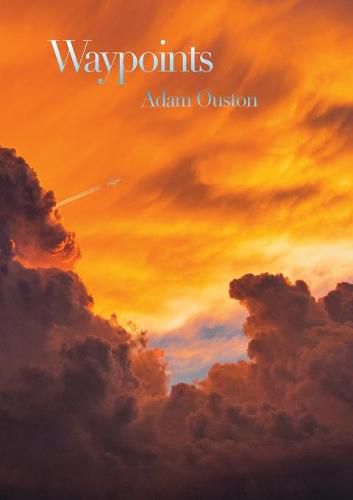 Adam Ouston, Waypoints (Puncher & Wattmann)
Adam Ouston, Waypoints (Puncher & Wattmann)
Reviewed by Vince Haig
In an interview promoting the release of his documentary television series, Can't Get You Out of My Head, The New Statesman described the work of filmmaker Adam Curtis as having a very particular style: “whiplash digressions, menacing atmospherics ... the near psychedelic compilation of archive footage.” The cover copy of Adam Ouston's novel Waypoints invokes WG Sebald and Thomas Bernhard by name, but it was to Adam Curtis that I found myself coming back to when reaching for familiar landmarks.
Arthur Bernard Cripp, Bernard to those who know him, has inherited a failing circus, but now the miserable last tour has been packed away and he spends his time caring for his father, who is slowly succumbing to Alzheimer's disease.
More troubling, it becomes apparent that Cripp's wife and daughter were passengers on the Malaysia Airlines flight 370, which disappeared in 2014. The uncertainty of their fate and the whereabouts of their remains -- mysteries exacerbated further by conspiracy and circumstance -- have left Cripp in a state beyond simple grief. In desperation, he fixates on a bizarre project. He will build his own Voisin II biplane and recreate Harry Houdini's failed 1910 attempt to become the first person to fly a powered craft over Australian soil. Houdini was beaten to the punch, but, as Cripp observes, no-one really remembers who succeeded in his place, which fashions a historical act of failure into a peculiar kind of success.
This, he argues, will serve as an act of time travel. “[I] would speak to the air and return to that age of awe, when there was still a sense of the impossible, when things occurred for the first time and not as a matter of routine…”.
In films like The Power of Nightmares and All Watched Over By Machines of Loving Grace, Adam Curtis works in collage; polemical essays tracing abstract connections between historical events of various scales, set against a backdrop of archive material -- news and current affairs footage, certainly, but also fitness videos, musicals, shopping channel idents, weather forecasts–all sped up, slowed down, played in reoccurring loops so that they take on an unsettling, dreamlike quality.
Ouston works on a similar register, but his focus cleaves to something far more personal. Cross-cutting history and conjecture with Cripp's own fictional narrative to create something conspiratorial and new.
Waypoints is an anxiety dream of a novel. A conspiracy theorist's murder-board of striking images connected by a web of red tape. In a breathless spiralling narrative told (more or less) in a single feverish paragraph, Cripp pinballs from one association to another, circling back to grasp at his bearings before bouncing off again into further tangents, digressions, curlicues and cul-de-sacs. In lengthy, slippery sentences, he details the history of Houdini's failed record-breaking attempt, he dips into Victorian showmanship, the swirl of misinformation around the disappearance of MH370, the history of powered flight, Alzheimer's disease and Australia itself.
“...I would happily put all awe and wonder to bed for the sake of complete knowledge - give me the apple and I'll take a whopping bite out of it--Houdini would be aghast at the concept of the YouTube tutorial, but I welcomed it, with open arms I ran towards the age of absolute knowing, I'd have us fill up every underground tunnel, every old mine, every cave, every hidden source of water, pack them full of blinking servers, racks and racks of hard drives, ship them out to the desert in a never-ending convoy of roadtrains, bring on the great debunking, wonder be damned, for as long as there was hope that we were on the brink of the age of knowing, I could forestall to some degree the anxiety of not knowing…”.
The effect is both exhilarating and exhausting, and there are moments when reading the novel feels a little like being cornered in a pub by a sincere but knowledgeable drunk.
With such an encyclopaedic approach, it's perhaps inevitable that some elements resonate stronger than others. Everything involving Houdini sings, for example, particularly the weirder anecdotes such as his escapology performance in the Yarra river, where his triumphant return to the surface is accompanied by a bobbing corpse that had long been trapped in the mud. By contrast, a late aside that Elon Musk might be counted on to find a cure to Alzheimer's, has not aged well over the past few months and, as a consequence, makes Cripp sound more naive than was perhaps intended.
For all of this, its whirligig narrative, its manic bricolage of anecdote, digression and reference; for all the high winds of the culture of distraction it abhors, the sheer force of detail achieves a critical velocity. Waypoints gets itself off the ground, and the final few pages achieve a melancholy kind of transcendence.
It's a strange, ambitious, reckless thing. But it flies; it really flies, and you can't deny there's awe in that.
